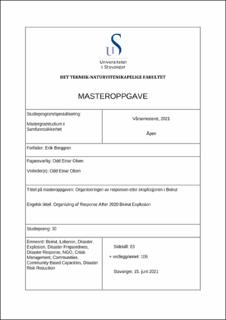| dc.description.abstract | The 2020 Beirut explosion caused massive destruction to the city’s infrastructure, causing 204
deaths as well as roughly 15 billion US Dollars in property damage. Lebanon has a lack of a
standardized disaster response framework, leaving the Lebanese Army as the only mechanism
for disaster response in the country. This might work in smaller events and crises, but in a
disaster, a large international mobilization is required, with clear and well-defined roles for
every contributor in the response. With the lack of a real disaster response framework in the
country, a highly active civil society has evolved in the country. This is mostly due to the
citizen’s lack of faith in the government – a factor that led to a high number of volunteers and
local NGOs participating in the response after the explosion. The purpose of this thesis was to
explore how the response after the Beirut explosion was organized. To do this I also
formulated three research questions, dividing the response into three categories – government,
international organizations, and local communities.
With this thesis being constructed during the Covid-19 pandemic, fieldwork became virtually
impossible, meaning that all of the data collected and used in this thesis was gathered
through document studies and interviews.
The theoretical framework of this thesis was focused on crisis management and other
strategies for risk mitigation. With the response after the explosion being categorized on a
large number of volunteers and local NGOs, a fair amount of the theoretical framework was
also dedicated to community based capacities. This was included to explore and analyze how
the local communities organized their response.
The response after the 2020 Beirut explosion was mostly organized through an informal
decentralization due to the lack of a standardized disaster preparedness framework in the
country. This meant that the international organizations had their own framework for
organizing their response, leading to a multi-sectoral response involving several
organizations. The two largest contributors here were the UN and the Red Cross. The same
was the case regarding the local communities, who had to create their own crisis management
structures to organize their response. With Lebanon already having a large number of NGOs,
there were already several established organizational structures available with a basis for
volunteer mobilization, leading to a more effective response. Furthermore, many ad-hoc
structures and initiatives were formed to coordinate the large number of volunteers. | |
